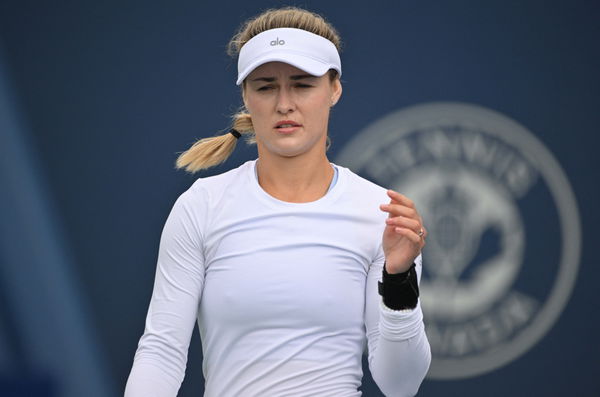
USA Today via Reuters
Aug 8, 2024; Toronto, Ontario, Canada; Anna Kalinskaya reacts after winning a game against Lesia Tsurenko (UKR, not shown) in second round play at Sobeys Stadium. Mandatory Credit: Dan Hamilton-USA TODAY Sports

USA Today via Reuters
Aug 8, 2024; Toronto, Ontario, Canada; Anna Kalinskaya reacts after winning a game against Lesia Tsurenko (UKR, not shown) in second round play at Sobeys Stadium. Mandatory Credit: Dan Hamilton-USA TODAY Sports
It’s time for controversy at the US Open! Anna Kalinskaya was leading 2-0 in the first set when she challenged a point against her opponent, Beatriz Haddad Maia, claiming a double bounce. Chair umpire Miriam Bley used a tablet to review the action. The outcome? Instead of a break point in favor of Anna, she decided to award the point to the Brazilian, deeming the shot valid. “If it’s for this… then don’t use VAR at all.”
Haddad Maia was 1-3 in the first set but later on, she managed to pull things back on track and won the set by 6-3. Kalinskaya struggled to regain her composure after the controversial call, winning only two of the next 14 games. The Brazilian left-hander eventually advanced to the Round of 16, where she will face former world No. 1 Caroline Wozniacki.
Renowned tennis journalist Jose Morgado came up with a tweet stating, “What? AHAHAHAHAHAH It’s a clearly ILEGAL PLAY!!!!!! Everybody is watching.”
ADVERTISEMENT
Article continues below this ad
One of the most embarrassing moments of this #USOpen.
If it’s for this… then don’t use VAR at all.
Kalinskaya was in shock as we all would be. pic.twitter.com/qicy4vYPTD
— José Morgado (@josemorgado) September 1, 2024
We have seen players say, “We have this proof every week that when the tournament is with electronic line calling, we don’t have these troubles.” Several of them have been previously engaged vocally in the battle of machine versus human eye. However, even after implementing new technologies, this incident with Kalinskaya shows us there is still a lot of improvement needed to make this sport more transparent and hassle-free.
If we go a little back, the electronic line calling system has been in place since 2006, when the Hawk-Eye technology was first approved for the hard court. During that time, we saw several controversial moments during the matches featuring these types of line calls. For example, do you remember even Serena Williams was once a victim of an incorrect call in her QF match at the 2004 US Open against Jennifer Capriatti?
ADVERTISEMENT
Article continues below this ad
Williams had described the 2004 US Open quarterfinal loss to Jennifer Capriati as “impossible to play” due to numerous incorrect line calls. The match is often credited with the introduction of Hawk-Eye, a technology designed to improve line calls. There have been many such players, like Kalinskaya and Williams, who have been victims of poor calling in the past. Let’s take a look at some of the recent ones.
Will Anna Kalinskaya’s misfortune yet again spark up a new controversy in the tennis world?
Previously we saw Coco Gauff slamming the umpire over a line calling during her SF at the French Open against Iga Swiatek. Then last year at the Wimbledon, Andy Murray suffered a heart-breaking umpiring error in his R2 match against Stefanos Tsitsipas. Even Novak Djoković was spotted raising his voice against poor officiating multiple times in his career.
ADVERTISEMENT
Article continues below this ad
Recently, the Serb raised his voice against a similar controversial incident featuring Felix Auger-Aliassime and Jack Draper at the Cincinnati Masters. “It’s embarrassing that we don’t have video replay of these kinds of situations on the court. What’s even more ridiculous is that we don’t have the rule in place that would allow chair umpires to change the original call based on the video review that happens off the court,” said Djokovic.
He was clearly disappointed with that incident and even Andy Roddick has spoken about these things in the past. According to the American, “It shouldn’t be on the player to have to do the umpire’s job while also trying to navigate a match. It’s not something you should have to worry about.” The call for electronic systems to help us get better calls is quite justified, but when these electronic calling systems get ‘overturned’, then what should the players do?
ADVERTISEMENT
ADVERTISEMENT
ADVERTISEMENT
ADVERTISEMENT
